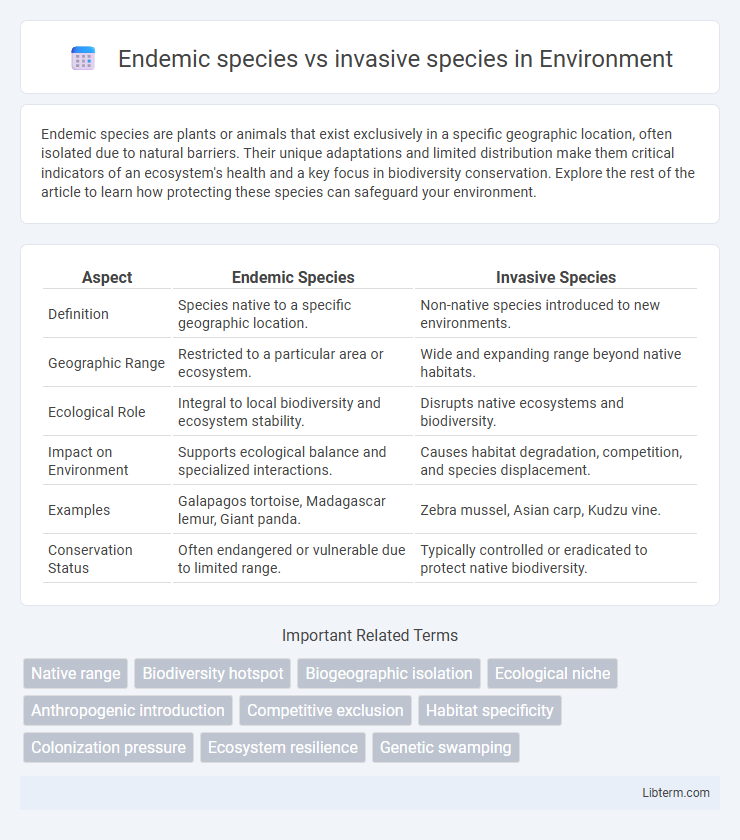Endemic species are plants or animals that exist exclusively in a specific geographic location, often isolated due to natural barriers. Their unique adaptations and limited distribution make them critical indicators of an ecosystem's health and a key focus in biodiversity conservation. Explore the rest of the article to learn how protecting these species can safeguard your environment.
Table of Comparison
| Aspect | Endemic Species | Invasive Species |
|---|---|---|
| Definition | Species native to a specific geographic location. | Non-native species introduced to new environments. |
| Geographic Range | Restricted to a particular area or ecosystem. | Wide and expanding range beyond native habitats. |
| Ecological Role | Integral to local biodiversity and ecosystem stability. | Disrupts native ecosystems and biodiversity. |
| Impact on Environment | Supports ecological balance and specialized interactions. | Causes habitat degradation, competition, and species displacement. |
| Examples | Galapagos tortoise, Madagascar lemur, Giant panda. | Zebra mussel, Asian carp, Kudzu vine. |
| Conservation Status | Often endangered or vulnerable due to limited range. | Typically controlled or eradicated to protect native biodiversity. |
Defining Endemic and Invasive Species
Endemic species are organisms native to and restricted within a specific geographic area, often evolving unique adaptations to their local environment. Invasive species are non-native organisms introduced to new regions, where they can disrupt ecosystems by outcompeting native species and altering habitats. Understanding the distinction is crucial for biodiversity conservation and ecosystem management strategies.
Key Differences Between Endemic and Invasive Species
Endemic species are native organisms restricted to a specific geographic location, often evolving unique adaptations to their local environment, which contributes to biodiversity and ecological balance. Invasive species are non-native organisms that spread rapidly in new habitats, often outcompeting native species and disrupting ecosystems. The key differences lie in their origin, ecological impact, and role in biodiversity conservation, with endemic species enhancing local ecosystems and invasive species posing threats to native flora and fauna.
Geographic Distribution and Habitat Range
Endemic species have a limited geographic distribution, often confined to specific islands, regions, or ecosystems, resulting in specialized habitat ranges adapted to unique environmental conditions. In contrast, invasive species exhibit broad geographic distribution, capable of colonizing diverse habitats beyond their native ranges due to high adaptability and competitive advantage. The restricted range of endemic species makes them more vulnerable to habitat loss, while invasive species frequently disrupt local ecosystems by outcompeting native flora and fauna.
Evolutionary Adaptations of Endemic Species
Endemic species exhibit unique evolutionary adaptations shaped by isolated environments, such as specialized feeding strategies, reproductive mechanisms, and physiological traits that enhance survival in specific habitats. These adaptations result from long-term genetic isolation and selective pressures, leading to high levels of biodiversity and ecological specialization. In contrast, invasive species often lack such specialized adaptations but thrive by rapidly reproducing and outcompeting native organisms in new ecosystems.
Ecological Impact of Invasive Species
Invasive species disrupt native ecosystems by outcompeting endemic species for resources such as food, habitat, and breeding sites, leading to a decline in biodiversity. They often introduce new diseases and alter soil chemistry, water availability, and fire regimes, which can significantly degrade ecosystem functions. The ecological impact of invasive species results in habitat loss, shifts in species composition, and compromised ecosystem resilience, threatening overall environmental stability.
Threats Posed by Invasive Species to Endemic Biodiversity
Invasive species disrupt endemic biodiversity by outcompeting native organisms for resources, leading to population declines and potential extinctions. These non-native species often introduce diseases and predators to which endemic species have no defenses, significantly altering ecosystem dynamics. The loss of endemic species due to invasive threats reduces genetic diversity and destabilizes ecological balance, impairing ecosystem services.
Case Studies: Endemic Species in Danger
Endemic species are native to specific regions and often face threats from invasive species that disrupt their ecosystems. Case studies of endangered endemic species, such as the Madagascar lemurs and Hawaii's native honeycreepers, highlight habitat loss and competition from invasive species like rats and feral cats as primary causes of decline. Conservation efforts emphasize habitat restoration and invasive species control to protect these irreplaceable elements of biodiversity.
Management and Control of Invasive Species
Management and control of invasive species involve early detection, rapid response, and continuous monitoring to prevent ecological and economic damage. Techniques include mechanical removal, chemical treatments, biological control agents, and public awareness campaigns to reduce spread and impact. Protecting endemic species requires habitat preservation and strict regulations to limit introduction and establishment of invasive species.
Conservation Strategies for Protecting Endemic Species
Conservation strategies for protecting endemic species emphasize habitat preservation, strict regulation of land use, and the control or eradication of invasive species that threaten native biodiversity. Implementing biosecurity measures to prevent the introduction of invasive species, alongside restoration ecology efforts, supports the recovery of endemic populations. Genetic monitoring and community engagement further enhance the resilience of endemic species within their natural ecosystems.
Future Challenges and Research Directions
Future challenges in managing endemic and invasive species include climate change impacts altering habitats and species distributions, necessitating advanced predictive modeling and monitoring techniques. Research directions emphasize genetic studies and ecosystem resilience assessments to inform conservation strategies and invasive species control. Innovative biocontrol methods and habitat restoration efforts remain critical to safeguarding biodiversity and ecosystem stability.
Endemic species Infographic

 libterm.com
libterm.com